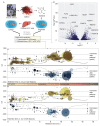Molecular Mechanisms behind Safranal's Toxicity to HepG2 Cells from Dual Omics
- PMID: 35740022
- PMCID: PMC9219844
- DOI: 10.3390/antiox11061125
Molecular Mechanisms behind Safranal's Toxicity to HepG2 Cells from Dual Omics
Abstract
The spice saffron (Crocus sativus) has anticancer activity in several human tissues, but the molecular mechanisms underlying its potential therapeutic effects are poorly understood. We investigated the impact of safranal, a small molecule secondary metabolite from saffron, on the HCC cell line HepG2 using untargeted metabolomics (HPLC-MS) and transcriptomics (RNAseq). Increases in glutathione disulfide and other biomarkers for oxidative damage contrasted with lower levels of the antioxidants biliverdin IX (139-fold decrease, p = 5.3 × 105), the ubiquinol precursor 3-4-dihydroxy-5-all-trans-decaprenylbenzoate (3-fold decrease, p = 1.9 × 10-5), and resolvin E1 (-3282-fold decrease, p = 45), which indicates sensitization to reactive oxygen species. We observed a significant increase in intracellular hypoxanthine (538-fold increase, p = 7.7 × 10-6) that may be primarily responsible for oxidative damage in HCC after safranal treatment. The accumulation of free fatty acids and other biomarkers, such as S-methyl-5'-thioadenosine, are consistent with safranal-induced mitochondrial de-uncoupling and explains the sharp increase in hypoxanthine we observed. Overall, the dual omics datasets describe routes to widespread protein destabilization and DNA damage from safranal-induced oxidative stress in HCC cells.
Keywords: DNA damage; cancer; hepatocellular carcinoma; hypoxanthine; natural products; saffron; safranal.
Conflict of interest statement
The authors declare no conflict of interest. The funders had no role in the design of the study; in the collection, analyses, or interpretation of data; in the writing of the manuscript, or in the decision to publish the results.
Figures



Similar articles
-
Safranal Prevents Liver Cancer Through Inhibiting Oxidative Stress and Alleviating Inflammation.Front Pharmacol. 2022 Feb 1;12:777500. doi: 10.3389/fphar.2021.777500. eCollection 2021. Front Pharmacol. 2022. PMID: 35177980 Free PMC article.
-
Saffron bioactives crocin, crocetin and safranal: effect on oxidative stress and mechanisms of action.Crit Rev Food Sci Nutr. 2022;62(12):3232-3249. doi: 10.1080/10408398.2020.1864279. Epub 2020 Dec 24. Crit Rev Food Sci Nutr. 2022. PMID: 33356506 Review.
-
Protective Effect of Safranal, a Constituent of Crocus sativus, on Quinolinic Acid-induced Oxidative Damage in Rat Hippocampus.Iran J Basic Med Sci. 2013 Jan;16(1):73-82. Iran J Basic Med Sci. 2013. PMID: 23638295 Free PMC article.
-
Protective effects of saffron and its active components against oxidative stress and apoptosis in endothelial cells.Microvasc Res. 2018 Jul;118:82-89. doi: 10.1016/j.mvr.2018.03.003. Epub 2018 Mar 7. Microvasc Res. 2018. PMID: 29524452
-
The role of Safranal and saffron stigma extracts in oxidative stress, diseases and photoaging: A systematic review.Heliyon. 2021 Feb 10;7(2):e06117. doi: 10.1016/j.heliyon.2021.e06117. eCollection 2021 Feb. Heliyon. 2021. PMID: 33615006 Free PMC article. Review.
Cited by
-
A Novel Oncogenic Role of Disulfidptosis-related Gene SLC7A11 in Anti-tumor Immunotherapy Response to Human Cancers.Curr Cancer Drug Targets. 2024;24(8):846-866. doi: 10.2174/0115680096277818231229105732. Curr Cancer Drug Targets. 2024. PMID: 38303526
-
Effect of lifestyle modification on hepatocellular carcinoma incidence and mortality among patients with chronic hepatitis B.World J Gastroenterol. 2023 Jun 28;29(24):3843-3854. doi: 10.3748/wjg.v29.i24.3843. World J Gastroenterol. 2023. PMID: 37426323 Free PMC article.
-
Integrating pharmacological evaluation and computational identification for deciphering the action mechanism of Yunpi-Huoxue-Sanjie formula alleviates diabetic cardiomyopathy.Front Pharmacol. 2022 Sep 5;13:957829. doi: 10.3389/fphar.2022.957829. eCollection 2022. Front Pharmacol. 2022. PMID: 36147338 Free PMC article.
-
LARP1 knockdown inhibits cultured gastric carcinoma cell cycle progression and metastatic behavior.Open Life Sci. 2024 Jan 22;19(1):20220806. doi: 10.1515/biol-2022-0806. eCollection 2024. Open Life Sci. 2024. PMID: 38283117 Free PMC article.
-
Tyrosine Kinase Inhibitor Lenvatinib Causes Cardiotoxicity by Inducing Endoplasmic Reticulum Stress and Apoptosis through Activating ATF6, IRE1α and PERK Signaling Pathways.Recent Pat Anticancer Drug Discov. 2025;20(2):168-184. doi: 10.2174/0115748928265981231204044653. Recent Pat Anticancer Drug Discov. 2025. PMID: 38994620
References
LinkOut - more resources
Full Text Sources

